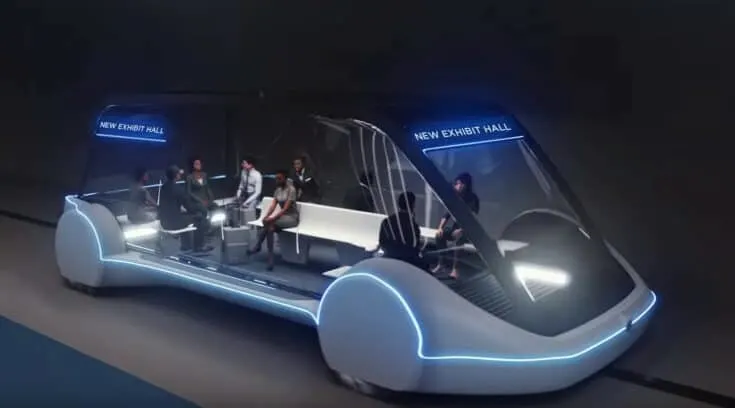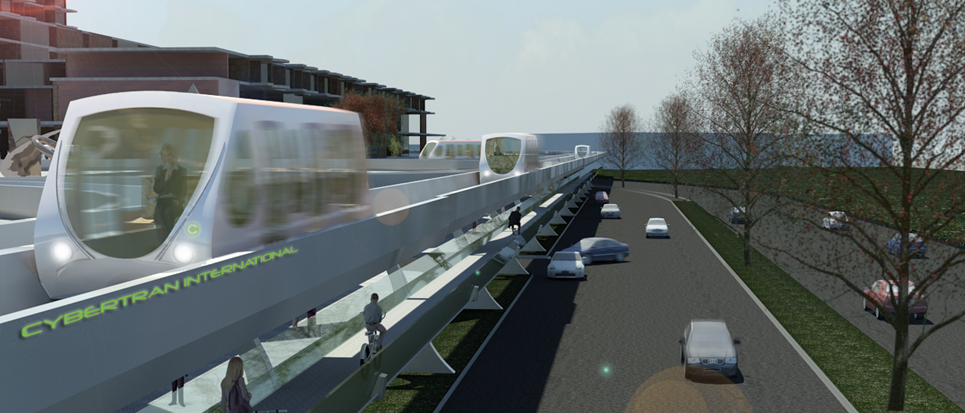Incremental Steps
Incremental steps for transportation change

Photo credits: China maglev (from Futurism.com), Boring Company (from lasvegasthenandnow.com)
Incrementalism is the slow consistent cultural move towards radical change. The most dramatic changes are seen in technology. With all the advances over the past one-hundred years, transportation has seen little change. There has to be an available product to enable a direction for change. Although there are several advanced transit technology companies, there has been little activity. Other than Morgantown opening in 1975 and Vectus in 2013, any semblance to advanced transit has been restricted to amusement parks and parking lot circulators.
The greatest advancements in ground transportation technology are in China with their high-speed magnetic levitation (maglev) train deployments. The fact that China is the global leader in advanced transit technology system deployments is a startling statement. Historically, nearly all technological advances are innovations from non-communist countries. It's the intent of CATTCC articles to be strictly related to transportation, rather than philosophies, merits, and practices of political ideologies. However, pointing out the fact that China is the global leader in advanced transit technology serves to highlight that lobbying policies of free-world politics, have bred a monopoly of corporate dominance which operate global public transportation; restricting any advances in transportation technology.
Transportation innovation
Some may argue that the advent of autonomous cars is a tremendous advance to transportation. While this achievement is indeed remarkable, the technology belongs to the computer industry; it’s computer programing applied to the automobile. This changes nothing from the car being a car. It’s still unsustainable environmentally, economically, and socially. It also has little to no effect to the automobile centric land-use design of urban growth.
The unified concept for all modern modes of transportation is focused on the engineering necessity for acceleration to propel vehicle movement. The one current implementation towards true transportation advancement is shown with the simplistic utilization of gravity in space travel. All the efforts of mankind’s engineering genius with propulsion driven vehicles and aircrafts were exceeded by the success in the mission of the Parker Solar Probe. This mission begs consideration for alternative methods of transportation motion beyond propulsion.
The focus of this article is in regards to the incremental movements to advance transit. The Parker Solar Probe imparts needed research in developing new concepts in physics theory; for technology in a new mode of transportation using brand-new methodologies for mobility. While detailing gravity is beyond the scope of this particular article, such articles can be found in other CATTCC posts.
Transit technology options
How then can incremental transportation advances be met? One technology is CyberTran, an advanced transit system designed for urban transit. As an autonomous vehicle and computer-controlled transit system, it provides 24/7 passenger access. This ultralight transit technology has passive switching which allows direct to destination passenger delivery. Due to its ultralight structure and smaller than streetcar design, its network infrastructure is a fraction of costs of traditional transit for full system implementation.
Hyperloop is a high-speed technology. Hyperloop was introduced as an open-source white-paper in 2013 by Elon Musk to provide a unified technology transit system. The system technology anticipates a speed above 700 mph. The vehicles travel inside an air evacuated tube to reduce air resistance which increases vehicle speed. The tube has a magnetic guideway and levitates the vehicles which further reduces friction, greatly increasing vehicle speed.
The engineered design of the Hyperloop transit system is configured for long distance. Although this is a much-needed addition to regional and long-distance transportation, the design is unsuitable for localized mobility in urban use.
ET3 is an ultrafast global transit technology. Their slogan is “Space travel on Earth”. It is indeed the fastest transportation system on the planet; its computer simulated speed reaches Mach 6. The basis of this technology is very simple: it works by eliminating virtually all aerodynamic friction and rolling resistance. The technology is an air evacuated tube with smaller vehicles than Hyperloop, it’s maximum load is 6 passengers and luggage. It’s smaller size, minimizes costs and increases speed.
This transit system design is the fastest long-distance travel technology in the world. However, similar to Hyperloop, it’s incapable of providing localized short-distance transit.
The only actively growing advanced transit project is from the Boring Company. The beginning of the Vegas Loop was built in about a year and opened in April of 2021. It started with the Las Vegas Convention Center Loop project as a three-station system with 1.7 miles of tunnel. In 2024, the Loop expanded with an addition of 2.1 miles and five stations. Future plans call for a total of 68 miles of tunnel and 90-stations throughout Las Vegas.
From an informative article in Investopedia about the Boring Company, it concludes with: “seeks to redefine our infrastructure and transportation systems via the use of tunnels.”
The aspect of new transportation infrastructure strengthens the demand for new transportation technology. Hyperloop and ET3 both use maglev technology. Due to the lack of an available technologically developed and publicly implemented vehicle system, the Boring Company had to implement what it had available: Tesla cars.
This step of transportation incrementalism is interesting. It’s a direction for infrastructure rather than vehicle technology, nonetheless; it’s a positive step.
The change for transportation’s incrementalism
Incremental change needs a goal, without being arbitrary. As pointed out in the article ‘Alternative Transportation from a Car’: “Eliminating the automobile convolutes the functionality of the automobile centric land-use design used with nearly all Western Society.” In other words: removing the car from society is futile without a more suitable replacement.
What type of change can make a difference to transportation? When does the direction of serious research and development bring vehicle development into a brand-new mode of transportation? That level of change is only made possible by altering the conventional mindset of propulsion-based mobility. Transportation change has to seek other methods of movement, something other than propulsion force.
What direction should short distance transportation research go? Changes to the future, require actions that alter things we do today. Where are the answers today that can change tomorrow’s future for transportation?
The first direction is to rethink propulsion as an engineering must. What alternative is there to propulsion? The attractive force of gravity has already been proven to far exceed every aspect of propulsion for speed.
Much of CATTCC study and research is about the advancement of transportation. The articles in Future Transportation are specifically about how to attain transportation motion without propulsion.



